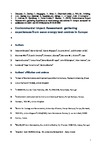Environmental Impact Assessment: Gathering experiences from wave energy test centres in Europe
| dc.contributor.author | Greaves, Deborah | |
| dc.contributor.author | Conley, Daniel | |
| dc.contributor.author | Magagna, D | |
| dc.contributor.author | Aires, E | |
| dc.contributor.author | Chambel Leitão, J | |
| dc.contributor.author | Witt, M | |
| dc.contributor.author | Embling, Clare | |
| dc.contributor.author | Godley, BJ | |
| dc.contributor.author | Bicknell, AWJ | |
| dc.contributor.author | Saulnier, J-B | |
| dc.contributor.author | Simas, T | |
| dc.contributor.author | O’Hagan, AM | |
| dc.contributor.author | O’Callaghan, J | |
| dc.contributor.author | Holmes, B | |
| dc.contributor.author | Sundberg, J | |
| dc.contributor.author | Torre-Enciso, Y | |
| dc.contributor.author | Marina, D | |
| dc.date.accessioned | 2016-04-28T15:15:10Z | |
| dc.date.available | 2016-04-28T15:15:10Z | |
| dc.date.issued | 2016-06 | |
| dc.identifier.issn | 2214-1669 | |
| dc.identifier.other | C | |
| dc.identifier.uri | http://hdl.handle.net/10026.1/4563 | |
| dc.description | publisher: Elsevier articletitle: Environmental Impact Assessment: Gathering experiences from wave energy test centres in Europe journaltitle: International Journal of Marine Energy articlelink: http://dx.doi.org/10.1016/j.ijome.2016.02.003 content_type: article copyright: © 2016 Published by Elsevier Ltd. | |
| dc.description.abstract |
The wave energy industry is an emerging sector and a new user of maritime space that has potential to contribute significantly to the EU renewable energy goals. International and national regulatory frameworks necessitate Environmental Impact Assessments (EIA) that provide important data to inform development consent decisions. Here we have evaluated experience related to the assessment programmes at EU wave energy test centres combined with knowledge gained from EIA produced for other similar renewable energy developments. From this we have identified key receptors of concern, as well as the type and magnitude of impacts which may be expected. The key environmental receptors of concern for wave energy EIA include the physical environment (e.g. morphology, waves and current) and flora and fauna1 as represented by marine mammals, seabirds, benthos, fish and shellfish. From a review of the EIAs performed at wave energy test centres, we identified several lessons regarding the wave energy EIA process. There is clear evidence that the receptors of primary interest are dependent on factors such as the local environmental characteristics, the presence/absence of protected species and the regulatory authority under which the EIA is performed. Furthermore, it is recommended that concerns relating to cumulative impacts, from an expanding level of wave energy development taking place in a background of growing utilisation of the marine environment, which are largely unknown at this early stage of the industry may be comprehensively addressed at the national level as part of a Strategic Environmental Assessment (EIA) and/or in Maritime Spatial Planning (MSP) and that it should be regularly reassessed. | |
| dc.format.extent | 68-79 | |
| dc.language | en | |
| dc.language.iso | en | |
| dc.publisher | Elsevier BV | |
| dc.subject | 7 Affordable and Clean Energy | |
| dc.subject | 13 Climate Action | |
| dc.title | Environmental Impact Assessment: Gathering experiences from wave energy test centres in Europe | |
| dc.type | journal-article | |
| dc.type | Journal Article | |
| plymouth.volume | 14 | |
| plymouth.publication-status | Published | |
| plymouth.journal | International Journal of Marine Energy | |
| dc.identifier.doi | 10.1016/j.ijome.2016.02.003 | |
| plymouth.organisational-group | /Plymouth | |
| plymouth.organisational-group | /Plymouth/Faculty of Science and Engineering | |
| plymouth.organisational-group | /Plymouth/Faculty of Science and Engineering/School of Biological and Marine Sciences | |
| plymouth.organisational-group | /Plymouth/Faculty of Science and Engineering/School of Engineering, Computing and Mathematics | |
| plymouth.organisational-group | /Plymouth/PRIMaRE Publications | |
| plymouth.organisational-group | /Plymouth/REF 2021 Researchers by UoA | |
| plymouth.organisational-group | /Plymouth/REF 2021 Researchers by UoA/UoA07 Earth Systems and Environmental Sciences | |
| plymouth.organisational-group | /Plymouth/REF 2021 Researchers by UoA/UoA12 Engineering | |
| plymouth.organisational-group | /Plymouth/Research Groups | |
| plymouth.organisational-group | /Plymouth/Research Groups/Marine Institute | |
| plymouth.organisational-group | /Plymouth/Users by role | |
| plymouth.organisational-group | /Plymouth/Users by role/Academics | |
| plymouth.organisational-group | /Plymouth/Users by role/Researchers in ResearchFish submission | |
| dcterms.dateAccepted | 2016-02-18 | |
| dc.rights.embargodate | 2017-6-1 | |
| dc.rights.embargoperiod | 12 months | |
| rioxxterms.versionofrecord | 10.1016/j.ijome.2016.02.003 | |
| rioxxterms.licenseref.uri | http://www.rioxx.net/licenses/under-embargo-all-rights-reserved | |
| rioxxterms.licenseref.startdate | 2016-06 | |
| rioxxterms.type | Journal Article/Review | |
| plymouth.funder | Flow & Benthic Ecology 4D (FLOWBEC)::NERC |


